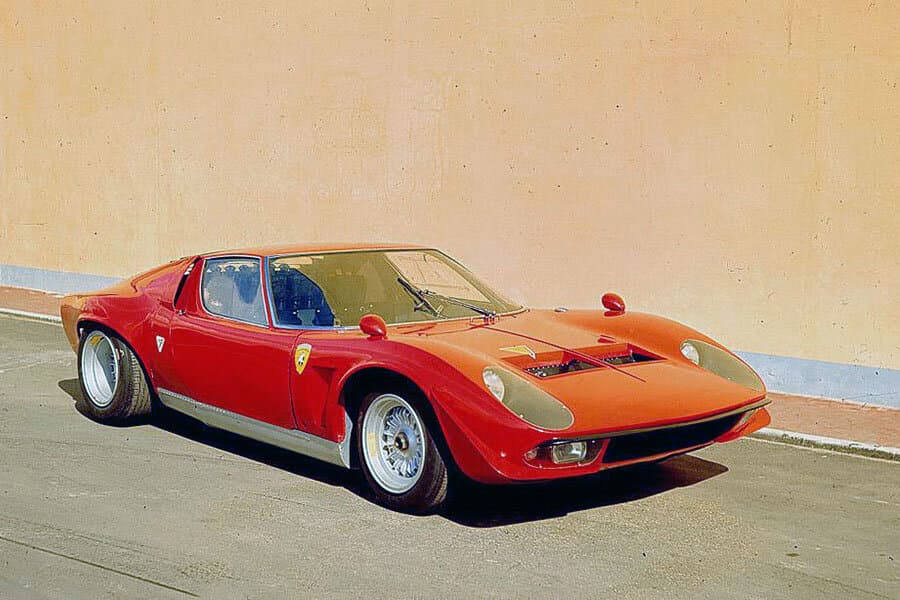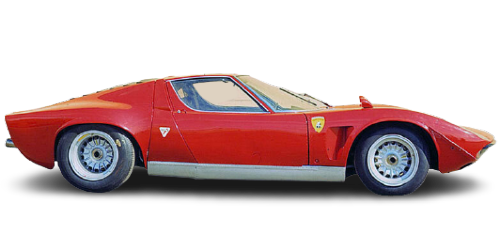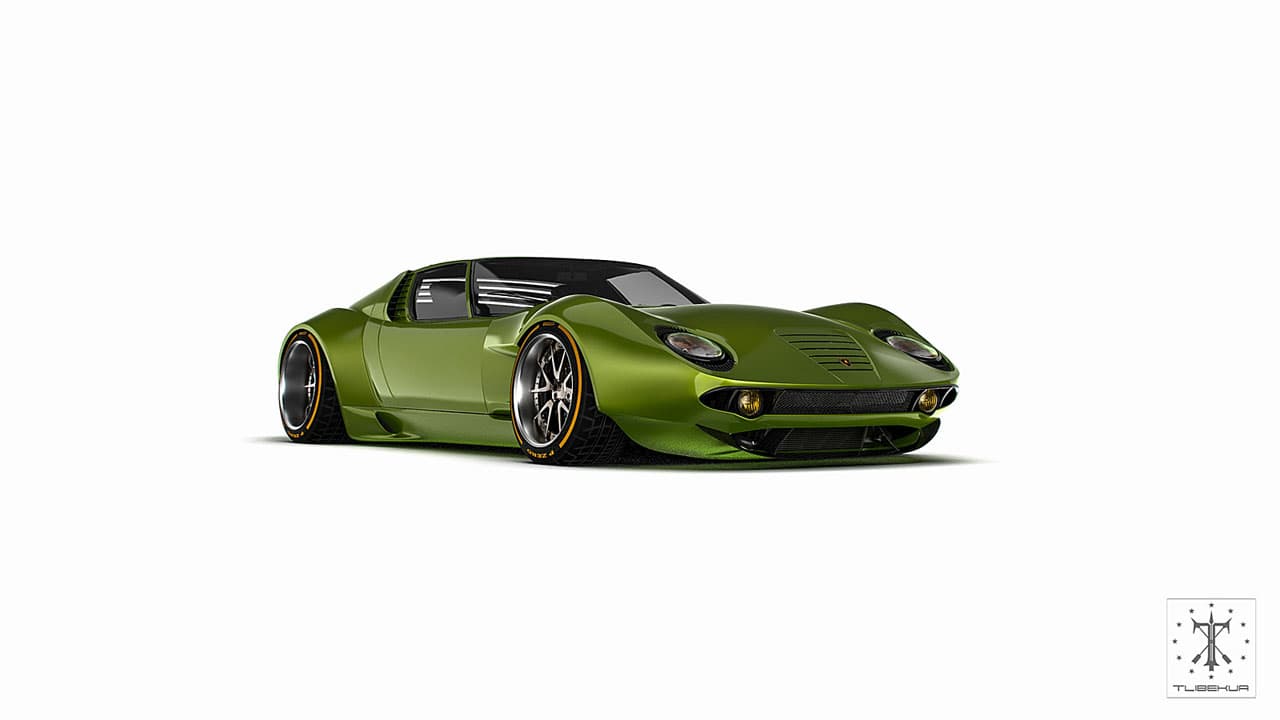If you mention the name Miura among car enthusiasts, chances are most of them know exactly what you are talking about, the Lamborghini Miura is an icon in automotive history, so what happens when Chief Test driver Bob Wallace ‘modifies’ one of these exotic super cars into a race car?
That is when the Jota comes into the picture, probably the most spectacular Lamborghini ever made and to date the most ambitious project Bob Wallace worked on during his days at Automobili Lamborghini back in 1970 he wanted to build a pure bred racing machine based on the magnificent Miura. Hence the name as the syllable ‘J’ is pronounced Yota in Italian, and coincidence or not appendix J was part of the International Auto Racing rulebook of that era.
But we all know the late Ferruccio didn’t have much intention to race any of his cars, so while he did allow Bob to use the factory tools, a genuine chassis from the line (number 5084 to be exact) and even use one of the brand new engines (number 30744 in fact) as a basis for his ‘toy’ but Bob did have a daytime job at the factory, so the Miura Jota had to developed during evenings and weekends.
From a distance the Jota still looked like a Miura, but up close a lot was different, just about the entire car was developed from the ground up most of the bodywork was now made from Avional, a very light, composite alloy usually only found in the aircraft industry, but Bob also removed the floor of the steel chassis and replaced it with this much lighter alloy. Back to the outside, the Miura Jota looked like a race car on the outside using fixed headlights covered by plastic covers that could be quickly replaced during a race if needed. Up front a large chin spoiler was mounted to counteract any lift due to the high speeds this Bull could reach.
All over the new bodywork air intakes and outlets were cut into the alloy, allowing cool air to enter and hot air to leave the car as smoothly as possible, in the hood two large, open outlets were present, just behind them a quick fuel filler it was to be a race car after all right. Behind the front wheels two massive vents were cut and both side windows had been replaced by plastic units with small sliding parts to allow a draft of air into the cockpit which didn’t have any air conditioning naturally, that’s only extra weight which means less performance.
The usual twin windshield wipers were removed and a single, parallelogram-action race wiper was mounted, on the roof two additional air intakes rammed air into the engine compartment while the louvers from the original Miura remain on the engine cover, however two more air outlets were cut in the rear panel and the entire lower grille was removed instead a quartet of thundering exhaust pipes were visible now.
Campagnolo supplied some of the widest, magnesium wheels on the market in the Seventies, a massive 12 inch wide at the back and 9 inch up front, 15 inch tall rolling initially on Dunlop racing slicks which were replaced by Pirelli later on. Years later Bob Wallace would mention he based the design of the Jota wheels on those found on a Bizzarrini, but let’s say this is part of the legend. Because of these ultra wide wheels the entire suspension also had to be redesigned, something Bob Wallace intended from the start naturally, he also created a near perfect weight distribution by putting a large spare wheel right at the back of the chassis and moving the single fuel tank into the side sills, 60 liter each something that would be the downfall of the Jota later on unfortunately.
With all that weight saving and redesign it would be wrong to leave the interior alone, so Bob Wallace completely stripped away everything he could get rid of, the dashboard was replaced with a lightweight plate holding only the strictly necessary dials and switches, the central console was never to be seen again and the roof mounted switches were placed on the dashboard itself now. The seats were replaced with padded foam ‘bags’ hanging from the structure between the cockpit and the engine perhaps not too comfortable, but it sure saved a lot of weight in the end.
As for the engine no doubt another masterpiece by Bob Wallace, he boosted the compression ratio, installed modified cams and a completely electronic ignition system add a dry sump lubrication to avoid having the engine oil all on one side during hard cornering and a somewhat louder exhaust with four megaphones and a nice 440 horsepower rating is the result. Note Bob actually used Islero sourced oil radiators for this Jota and a gearbox with closer ratios by the way, the pedals in the Jota hung from above, on the regular Miura the pedals actually stand up, another major modification only seen on the Jota.
Ferruccio still didn’t want to have one of his cars on the track, but he did allow to have the Miura Jota rigorously field tested, so it covered over 20,000 Kms on Pirelli test tracks with a proud Bob behind the wheel these test runs led to the development of the H60 VR15 tire that would be mounted on the ‘street’ Miura so the Jota was used as a test bed for new suspension development and tire testing under heavy strain but economic troubles would decide the Jota’s faith.
On February 8. 1972 the Jota was sold to InterAuto in Brescia for an undisclosed amount of money, imagine owning a one of a kind Miura that was more a race car than a road car to be honest, and it showed a mechanic would become a little over enthusiast while showboating the car to his girlfriend he hit the side of a bridge, ripping the side mounted fuel tanks causing the Jota to catch fire and burn down completely the fire was so intense most of the bodywork was destroyed, but also the chassis was warped beyond repair.
The Lamborghini Miura Jota was no more but at least it did get some attention in the automotive press which led to several inquiries by Miura owners who liked to have their own, standard Miura turned into a Jota edition. The factory never accepted building a second Jota, however several regular Miura were rebuilt to a certain level of Jota specifications some sources call these the Miura SVJ model.
Most of these factory replicas only had some bodywork modifications that included the extra intakes and outlets, most of them also got the fuel filler seen on the Jota, only three did get a dry sump lubrication none of them came even remotely close to the original Jota.
If we can rely on documentation of that time we can state the factory built these SVJ replicas on the following chassis numbers: 4860, 4990, 3781 and 5090, while the real Jota was built on chassis number 5084, with engine number 30744. As stated only the first three of these replicas had a dry-sump lubrication. The nr. 4860 was built for Hubert Hahne in Dusseldorf, Germany, the nr. 4990 was sold to Alberto Silvera in Port au Prince, Haiti, while a third one went to France.
But hold on there are still dedicated people out there, that have the means to realize their dreams, no matter at what cost so here comes Piet Pulford, a long time Lamborghini owner from the United Kingdom who invested 15 years and a massive amount of money to recreate the Lamborghini Miura Jota and he succeeded!
Piet started with a beaten, old Miura (#3033) sourced in the United States, but that didn’t matter as not much of the original car would remain in the end. The extensive bodywork and chassis modifications were entrusted to Chris Lawrence (Wymondham Engineering) in Norfolk note the entire front and rear section were only held onto the Jota by locating pins and Dzus fasteners to allow easy and quick removal.
Final assembly over the modified chassis wasn’t as easy as it might sound, once the engine, which was built by none other than Bob Wallace himself in Arizona to be as exact a replica of the original Jota engine and transmission as possible, oil tanks and auxiliaries required to run this car were fitted the massive lightweight sections were to be fitted very patiently. Don’t forget there is a large, quick fuel filler up front, peaking up into the front hood while at the rear we have four massive exhausts sticking out. But Roger Constable (The Car Works), also from Norfolk, pulled it together perfectly even Bob Wallace didn’t think it would be possible to recreate the Jota he even commented the workmanship on this second rendition of the Miura Jota could very well be better than his own back in the Seventies.
The Miura Jota used four massive exhaust pipes that looked very nice and purposeful on the car for track use, unfortunately the recreation of these were done so good they were just too loud to be used on the road, so Mr Pulford had four restrictors made for his Jota, these would just slide over the pipes and bring the sound level down enough to avoid being pulled over by the police every few Miles.
Due to the efforts of Piet Pulford we can now admire the Miura Jota once more, and listen to it when that free breathing 4 liter V12 engine comes to life you do not want to be standing at the rear of this car, the sound is deafening just like a Le Mans race car, at idle the sound is raw only touch the throttle mildly and an animal howl emits from the exhausts, put some more revs onto the engine and the sound goes beyond anything you might imagine.
Driving the Jota recreating proved surprisingly smooth, sure the front suspension transmits everything right up into the steering wheel, the sheet metal between the engine and the cockpit becomes way too hot to handle after a drive, there is no fuel gauge inside so you’ll have to guess how much fuel in still underneath your elbow in the side sills. With that much tire touching the road, there is no doubt about the enormous grip you have on a dry road once it gets wet you have to be a bit more careful I’m afraid.
So one of the most impressive cars ever made at Sant’Agata had been lost for years but thanks to this UK based enthusiast the Miura Jota has been resurrected from the grave the Bull rides again!




